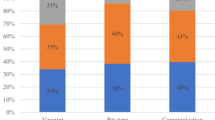Abstract
This paper reports the results of questionnaire-based research conducted at an exhibition of interactive humanoid robots that was held at the Osaka Science Museum, Japan. The aim of this exhibition was to investigate the feasibility of communication robots connected to a ubiquitous sensor network, under the assumption that these robots will be practically used in daily life in the not-so-distant future. More than 90,000 people visited the exhibition. A questionnaire was given to the visitors to explore their opinions of the robots. Statistical analysis was done on the data of 2,301 respondents. It was found that the visitors’ opinions varied according to age; younger visitors did not necessarily like the robots more than elderly visitors; positive evaluation of the robots did not necessarily conflict with negative evaluations such as anxiety; there was no gender difference; and there was almost no correlation between opinions and the length of time spent near the robots.








Similar content being viewed by others
References
Asada M, Obst O, Polani D, Browning B, Bonarini A, Fujita M, Christaller T, Takahashi T, Tadokoro S, Sklar E, Kaminka GA (2003). An overview of RoboCup-2002 Fukuoka/Busan. AI Mag 24(2):21–40
Burgard W, Cremers AB, Fox D, Hahnel D, Lakemeyer G, Schulz D, Steiner W, Thrun S (1998) The interactive museum tour-guide robot. In: Proceedings of the national conference on artificial intelligence (AAAI)
Friedman B, Kahn PH Jr, Hagman J (2003). Hardware companions? What online AIBO discussion forums reveal about the human–robotic relationship. In: CHI 2003 proceedings (long paper), pp 273–280
Fujita M, Kuroki Y, Ishida T, Doi T (2003). Autonomous behavior control architecture of entertainment humanoid robot SDR-4X. In: Proceedings 2003 IEEE/RSJ international conference on intelligent robots and systems, pp 960–967
Hirata K (1990) The concept of computer anxiety and measurement of it (in Japanese). Bull Aichi Univ Educ 39:203–212
Ikeda T, Ishida T, Ishiguro H (2004) Framework of distributed audition. In: Proceedings of the 13th IEEE international workshop on robot and human interactive communication (RO-MAN 2004)
Ishiguro H, Ono T, Imai M, Maeda T, Kanda T, Nakatsu R (2001) Robovie: an interactive humanoid robot. Int J Ind Rob 28:498–503
Kahn PH Jr, Friedman B, Perez-Granados DR, Freier NG (2004). Robotic pets in the lives of preschool children. In: Extended abstracts of CHI 2004, pp 1449–1452
Murakita T, Ikeda T, Ishiguro H (2004) Human tracking using floor sensors based on the Markov chain Monte Carlo method. In: Proceedings of the international conference on pattern recognition, pp 917–920
Ng KC, Ishiguro H, Trivedi MM, Sogo T (2004) An integrates surveillance system-human tracking and view synthesis using multiple omni-directional vision sensors. Image Vis Comput J 22:551–561
Nishimura T, Itoh H, Nakamura Y, Yamamoto Y, Nakashima H (2004) A compact battery-less information terminal for real world interaction. In: PERVASIVE 2004 (LNCS 3001). Springer, Berlin Heidelberg New York, pp 124–139
Nomura T, Kanda T, Suzuki T, Kato K (2004) Psychology in human–robot communication: an attempt through investigation of negative attitudes and anxiety toward robots. In: Proceedings of the 13th IEEE international workshop on robot and human interactive communication, pp 35–40
Nomura T, Kanda T, Suzuki T (2005) Experimental investigation into influence of negative attitudes toward robots on human–robot interaction. AI & Society. http://www.dx.doi.org/10.1007/s00146–005–0012–7
Raub AC (1981) Correlates of compute anxiety in college students. Doctoral dissertation, University of Pennsylvania
Sakagami Y, Watanabe R, Aoyama C, Matsunaga S, Higaki N, Fujimura K (2002) The intelligent ASIMO: system overview and integration. In: Proceedings of the IEEE/RSJ international conference on intelligent robots and systems (IROS’02), pp 2478–2483
Schulz D, Fox D, Hightower J (2003) People tracking with anonymous and id-sensors using Rao–Blackwellised particle filters. In: Proceedings of the international joint conference on artificial intelligence (IJCAI), pp 921–926
Shibata T, Wada K, Tanie K (2002) Tabulation and analysis of questionnaire results of subjective evaluation of seal robot at Science Museum in London. In: Proceedings of the international workshop on robot and human interactive communication (RO-MAN), pp 23–28
Shibata T, Wada K, Tanie K (2003) Subjective evaluation of a seal robot at the national museum of science and technology in Stockholm. In: Proceedings of the international workshop on robot and human interactive communication (RO–MAN), pp 397–407
Shibata T, Wada K, Tanie K (2004) Subjective evaluation of a seal robot in Burunei. In: Proceedings of the international workshop on robot and human interactive communication (RO-MAN), pp 135–140
Shiomi M, Kanda T, Ishiguro H, Hagita N (2006) Interactive humanoid robots for a science museum. In: Proceedings of the first annual conference on human–robot interaction (HRI2006), pp 305–312
Sumi Y, Matsuguchi T, Ito S, Fels S, Mase K (2003) Collaborative capturing of interactions by multiple sensors. In: Proceedings of the international conference on ubiquitous computing (Ubicomp), pp 193–194
Acknowledgments
This research was supported by the Ministry of Internal Affairs and Communications. We wish to thank the staff at the Osaka Science Museum for their highly appreciated cooperation and helpful suggestions: Hideaki Terauchi, Toshihiko Shibata, Koutarou Hayashi, Masaaki Kakio, Taichi Tajika, and Fumitaka Yamaoka.
Author information
Authors and Affiliations
Corresponding author
Rights and permissions
About this article
Cite this article
Nomura, T., Tasaki, T., Kanda, T. et al. Questionnaire-based social research on opinions of Japanese visitors for communication robots at an exhibition. AI & Soc 21, 167–183 (2007). https://doi.org/10.1007/s00146-006-0053-6
Received:
Accepted:
Published:
Issue Date:
DOI: https://doi.org/10.1007/s00146-006-0053-6




